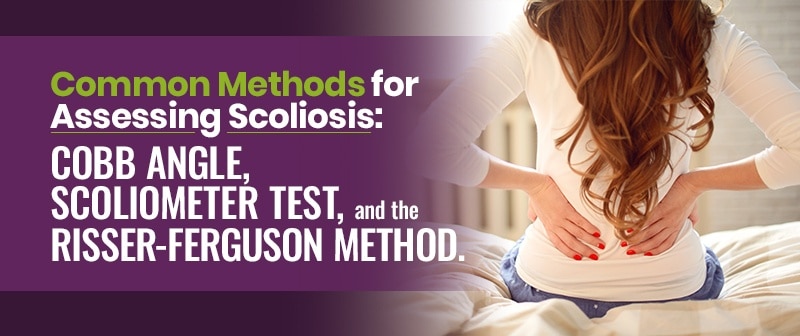
Scoliosis is an incurable and progressive condition characterized by an abnormally curved spine. When it comes to understanding what’s happening with a patient’s spine, there are a variety of assessment systems in place. The Scoliometer test, Cobb angle, and Risser-Ferguson Method are the most widely used and accepted.
Before we start exploring commonly-used measurements and tests that help determine what is happening with a patient’s spine, understanding the spine’s basic anatomy can be helpful, especially when it comes to anatomical terms and descriptions.
Generally, the spine is divided into four sections:
The cervical spine refers to the upper back that connects to the neck via seven vertebral segments.

The lumbar region is situated between the thoracic, or chest, region of the spine, and the sacrum.
Vertebrae are the individual bones that make up each section of the spine. The cervical spine consists of 7 vertebrae; the thoracic spine has 12; the lumbar spine has 5.

Each vertebra has several parts and purposes. The body of the vertebra is weight-bearing and is where the fibrous discs that separate each vertebra rest.
The spinal canal is covered by the lamina, and the large holes in the center of each vertebra are where the spinal nerves pass through to send messages to and from the brain and throughout the rest of the body.
If you run your hands along your spinal cord, the bony protruding bumps you’ll feel are the posterior (backside) of the vertebrae, known as the ‘spinous process’.
The ‘transverse process’ refers to the bony projections that extend from the right and left sides of each vertebra; thus each vertebra has two transverse processes which function as an attachment site for the spine’s muscles and ligaments.
Facet joints are small joints that sit behind and between adjacent vertebrae. Each level of the spinal column, except the upper cervical spine, has facet joints that provide it with stability and facilitate movement.
The facet joints are enclosed with fluid-filled capsules that protect and lubricate the joints. The posterior facet joints interact with the anterior (front side) disc space, forming a three-joint composite at each level of the spine. The composite joints facilitate the spine’s extension, rotation, and lateral bending.
The spine’s facet joints are virtually always in motion, which is why they are prone to degenerative changes.
Each vertebra is separated by an intervertebral disc. The intervertebral discs act as shock absorbers, provide the vertebrae with cushioning, and help protect the nerves running through the spinal canal.
Each disc contains a hard and durable outer layer (annulus) and a soft gel-like center (nucleus).
When the discs degenerate, they can bulge out to the side, causing the spine to become misaligned and scoliosis to develop.
Now that we have a basic understanding of the spine’s anatomy and its individual parts, its biomechanics (how the individual parts work together and function) can be better understood in relation to spinal deformities such as scoliosis.
As the leading cause of spinal deformity in children in the United States, the National Scoliosis Foundation reminds us that the condition is more common than many people realize.
One of the reasons the condition is more prevalent than people think is that it can be very difficult to diagnose, especially in the main age group affected by it (adolescents between the ages of 10 and 18).

As the adolescent stage is characterized by continuous growth and postural changes, many people assume changes in gait and posture are just natural changes associated with that age group.
The condition is also often painless for adolescents because the lengthening motion the spine experiences during growth counteracts the compression forces of the curvature, which are what causes pain and discomfort in and around the spine in adults who have stopped growing.
With 80 percent of known diagnosed scoliosis cases classed as ‘idiopathic’, meaning no known single cause, treatment efforts are focused on the best ways to screen for the condition for early detection, monitor the condition’s progression, and achieve a curvature reduction.
The Scoliometer test is used in conjunction with a forward bend test, also known as an Adam’s test. If it’s suspected that scoliosis might be present, a visual assessment is usually the first step to reaching a diagnosis. A Scoliometer is a noninvasive instrument used to screen for indicators of the condition.
A doctor will ask their patient to stand upright, then bend forward as if they’re going to touch their toes, at a 90-degree angle. From this position, any deformity is maximized and a curvature or related body asymmetries are more visible. In this position, doctors are looking for the rib arch caused by the abnormal rotation in the spine and use the scoliometer to measure the leaning points of each arch.
A forward bend test is performed in conjunction with an instrument called a ‘scoliometer’. The Scoliometer somewhat resembles a curved ruler with a ball that can move inside the instrument from side to side lining up with numbers that tell us the angle of trunk rotation (ATR) that’s present.
The base of the Scoliometer has a central notch that sits over the spinous process so it can be guided along the spine.
The location of the ball in the instrument lines up with numbers that represent the angle of trunk rotation. If the ATR measures at greater than 5 degrees, that indicates a potential spinal curvature that would warrant a referral to a specialist for further testing.
There are also scoliometer apps available for use on a mobile device so parents and caregivers can be proactive in screening their adolescents at home.
The Cobb angle is often referred to as the ‘gold standard’ for assessing scoliosis. The Cobb angle is measured via X-ray and is determined by the most tilted vertebrae in each curve.
The measurement is calculated by first drawing lines from the superior tilted vertebra’s top and the inferior tilted vertebra’s bottom. Next, two additional lines are drawn at a 90-degree angle to the first lines. The second set of lines is drawn perpendicular to the first so they intersect. From there, the angle is measured and expressed in numerical degrees.
Once a patient’s Cobb angle is determined, their condition can then be further classified by placing it on a scale from mild to severe. Generally, a scoliosis diagnosis is given when a Cobb angle measures more than 10 degrees.
While the Cobb angle is the most widely-used measurement for assessing a person’s scoliosis, it doesn’t give a complete picture of what’s happening with the entire spine. That being said, educating yourself so you know what questions to ask is the best way to ensure your, or a loved one’s, scoliosis X-ray is being read comprehensively.
When it comes to reading a scoliosis X-ray and using the information it provides to customize a treatment plan, this is where I highly suggest working with a doctor who specializes in scoliosis.
While most general practitioners can spot a spinal curvature, comprehensively reading a scoliosis X-ray involves much more than just measuring the Cobb angle. A scoliosis X-ray is, after all, a 2-dimensional image of a 3-dimensional condition.
Here at the CLEAR Scoliosis Institute, our doctors are experts when it comes to reading scoliosis X-rays and designing effective treatment plans based on the information they provide. They also take the overall health of the patient into account when assessing what is happening with the spine.

Scoliosis affects the spine on all of its three dimensions: sagittal (from front to back), coronal (from side to side), and axial (from top to bottom). The Cobb angle measurement only measures the spine’s tilt in one level and doesn’t give a full picture of what’s happening with every vertebra of the spine.
Being able to fully read and understand a patient’s scoliosis involves looking at the spine from multiple angles to gain a complete understanding of how the condition is affecting the spine on all three dimensions.
The best way to ensure a scoliosis X-ray is being read comprehensively is to make sure you are working with a specialist, such as one of our CLEAR-certified doctors of chiropractic.
Another aspect to be aware of when advocating for yourself, or a loved one with scoliosis, is the variability of the Cobb angle measurement.
A person’s Cobb angle measurement can vary if the same bones aren’t always used in its calculation. Also, the ways in which doctors draw the lines can vary, accounting for significant differences in the final angle calculation. These differences can lead to inaccuracies as large as 5 degrees.
If two X-rays are being compared, especially if they were taken by two different doctors, don’t be afraid to ask if the same bones were used in both calculations and how the lines were drawn; this will help determine if any differences are due to a measurement error or an actual change to the spine.
While the Scoliometer test and the Cobb angle are the most commonly used and accepted systems for assessing scoliosis, there are other methods that are less common, such as the Risser-Ferguson method.
The Risser-Ferguson method consists of assigning stages (0 to 5) to the steps of ossification and attachment of the iliac apophysis (sections of the pelvis). Put simply, ossification is the process by which bone tissue is formed, and the purpose of the Risser-Ferguson method is to gauge a patient’s overall skeletal development.
The higher the stage, the further along the patient is in reaching skeletal maturity, and this has a big impact on the chosen course of treatment for patients with scoliosis.
Here at the CLEAR Scoliosis Institute, we use several different measurement techniques to gain a 3-dimensional understanding of every patient’s condition. We want our measurements to reveal what is happening with the spine from every angle.
We don’t just look at a patient’s Cobb angle; we compare it alongside cosmetic and functional considerations to ensure that our treatment plans are truly improving the patient’s quality of life.
Our CLEAR approach is to use the latest X-ray technology in the form of seven specialized X-rays that assess the spine’s position 3-dimensionally. The combined X-rays yield 76 measurements that inform the customized treatment plan and exercise program that is most likely to make the spine move in the direction we want it to go.
While there are numerous systems in place for assessing scoliosis, the Scoliometer test, Cobb angle, and the Risser-Ferguson Method are the most common. These methods are effective ways to screen for the condition, classify the condition’s severity based on the degree of curvature, and determine where an adolescent is in terms of skeletal maturity.
The information that these assessment systems provide tell us what we need to know to best treat our patients and help them live their best lives throughout treatment and beyond.
“The author’s views are his or her own and may not reflect the views of CLEAR Scoliosis Institute.”

CLEAR provides a unique and innovative way of understanding scoliosis. Sign up to receive facts and information you won’t find anywhere else.
